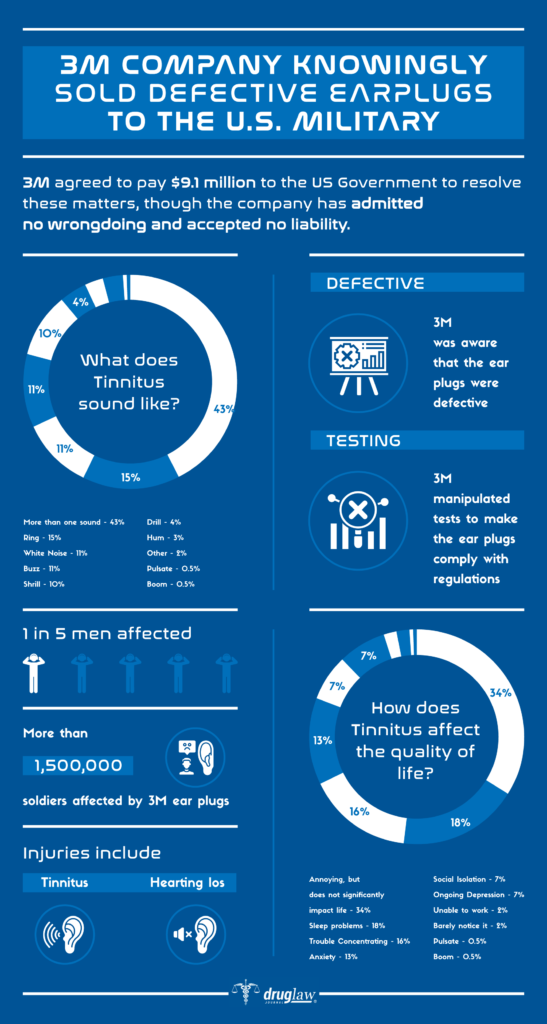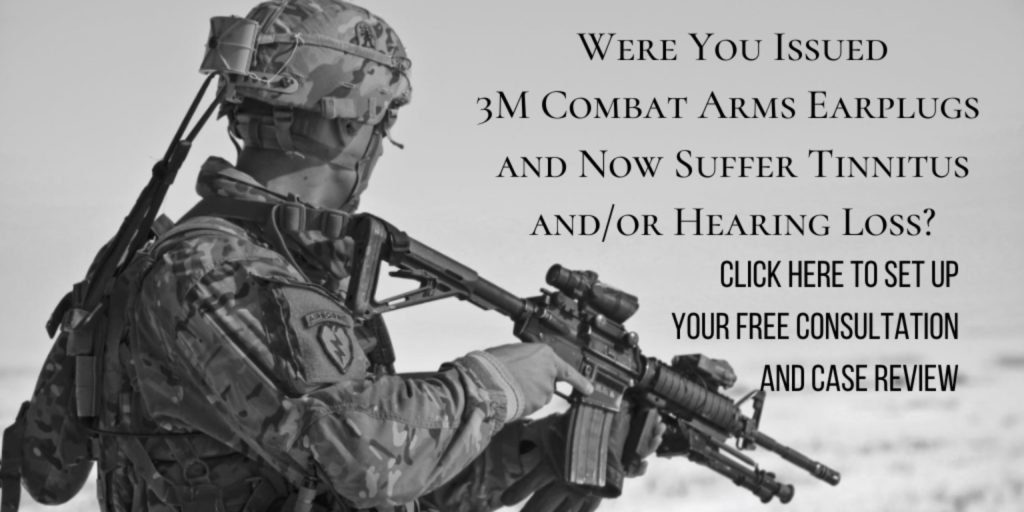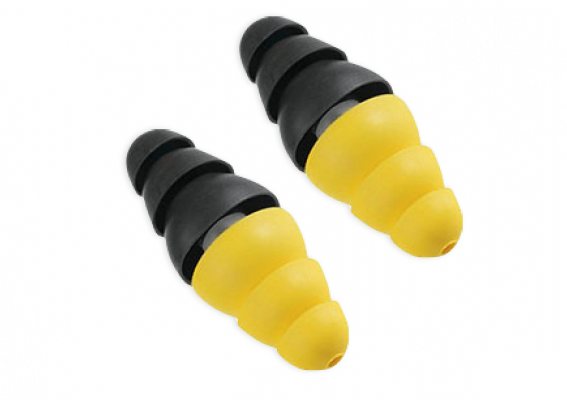Last updated October 12, 2021
The 3M Company and Aearo Technologies designed and manufactured specialized combat earplugs for U.S. servicemen and women which were supplied throughout combat zones in Iraq and Afghanistan between 2003 and 2015. Ostensibly, these devices were supposed to protect the hearing of our troops while offering them two fitting options for different types of encounters. In particular, one end of the 3M Combat Arms earplugs was supposed to protect against harmful battlefield noise levels while allowing troops to hear commands as well as the footsteps and other sounds from enemy combatants. Unfortunately, a design defect, one that both Aearo and 3M likely knew about in advance, allowed dangerous levels of noise to enter the ear and cause permanent hearing loss and tinnitus in many returning veterans.

Background and History
Aearo Technologies became the exclusive supplier of dual-ended combat arms earplugs for the entire U.S. military under an “Indefinite Quantity Contract” (IQC) awarded in 2003. Partially in response to the success of Aearo in securing such a lucrative contract, the defense contractor was acquired by 3M in 2008 and continued to supply earplugs through at least 2012.
The dual-ended combat arms earplugs manufactured by 3M and Aearo are known as “non-linear” or “selective attenuation” earplugs. This design was intended to permit soldiers to protect their hearing while choosing from either a “blocked” or “unblocked” fitting position in the ear. In the blocked position, the earplugs were supposed to perform as traditional earplugs and block as much potentially harmful noise as possible. In the “unblocked” position, the earplugs were intended to minimize loud impulse sounds (i.e. battlefield explosions, rockets, and artillery fire) while allowing quiet noises such as commands or footsteps to pass through.
Design Defect
However, as injured soldiers claim in multiple lawsuits, the earplugs did not perform as advertised. They believe that the combat earplugs’ instruction manual, in combination with an inherent design defect, involving the third-flange of the non-inserted end, prevented the plugs from fitting snugly in the ear canal. When the flange of the non-inserted end pressed against the ear, it folded and loosened the seal. Troops who believed their ears were being adequately shielded from battlefield noise were allegedly exposed to much higher-than-safe levels of decibels. It is believed that, at a minimum, thousands if not millions of soldiers have suffered significant hearing loss as a consequence.
3M and Aearo Knowledge of the Defect
At the dawn of the program in January 2000, testing of the combat arms earplugs began at Aearo’s own laboratories, rather than at an outside and independent laboratory. Aearo employees closely monitored the results of testing, which suggested that the noise reduction factor offered by the devices was far below what was considered adequate. Aearo determined that the positioning and fitting of the flanges in the design were the cause of the deficiency in the earplugs’ performance.
Aearo employees and engineers concluded that a snug fit on the “closed” end of the earplugs required the user the fold back the flanges on the “open” end in what was termed as a “modified” fitting procedure. Testing resumed in February 2000 using the modified fitting technique and the results of these tests were the basis for Aearo’s and eventually 3M’s claims about the noise reduction ratings for the combat arms earplugs.
Instructions for Proper Use
Despite allegedly knowing that their product contained a serious design defect that could render its claims of noise protection virtually meaningless, Aearo and 3M went ahead and sold the dual-ended combat arms earplugs to the U.S. military for several years. And potentially more damning, given what they knew about the defect and their own testing, they failed to include the “modified” fitting procedure in the standard “instructions for proper use” issued with the device.
Whistleblower Settlement
In 2016, a competing firm of Aearo/3M filed a federal whistleblower complaint claiming that 3M violated the False Claims Act concerning statements and representations it made to the U.S. Government concerning the safety record of the dual-ended combat arms earplugs. Specifically, Moldex’ claimed that 3M employees were well-aware that the earplugs did not perform as claimed to go all the way back to 2000. In July 2018, 3M agreed to settle the claims in the whistleblower complaint for $9.1 million without a direct admission as to any liability on the part of 3M.
Tinnitus and Hearing Loss
Tinnitus is described as a general ringing in the ears. According to the U.S. Department of Veterans Affairs, tinnitus is one of the most commonly reported disabilities among servicemen and women. It is widely understood that our nation’s fighting men and women are especially vulnerable to tinnitus and hearing loss due to excessive noise exposure from gunfire, explosions, and helicopter rotors.
These loud noises can permanently damage the cells within the inner ear causing much discomfort and loss of enjoyment of life. Veterans with tinnitus can hear a ringing, hissing, or buzzing that prevents concentration or sleep. On the other hand, hearing loss can make it difficult for someone to maintain relationships with loved ones and friends leading to depression or even cognitive decline.

Is there a Dual-End 3M Combat Arms Earplugs Lawsuit?
In 2019, veterans from across the United States began filing lawsuits naming 3M which claim that the company sold defective earplugs and then intentionally made false representations to the U.S. Government concerning the safety and effectiveness of the combat arms earplugs. These lawsuits have now been aggregated into a multidistrict litigation taking place in a federal court in Florida (MDL-2885). The first bellwether trials in the MDL began in April 2021. Some of the lead plaintiffs include:
Andrew Bridges
Bridges is a veteran of the United States Marine Corps who joined in 2006 at the age of 18 and was deployed to Iraq in 2009. He was supplied with dual-end 3M Combat Arms earplugs during his service and wore them during tank firing, training exercises, live-fire training, vehicle maintenance, and combat exercises. According to his complaint, Bridges was never instructed to fold back the flanges on the earplugs and in 2010 was first diagnosed with hearing issues, including sensorineural hearing loss and tinnitus.
John Ciaccio
Also a veteran of the United States Marine Corps, Ciaccio joined the Marines in 1991 and served until 2017, during which he was deployed to Iraq (twice) and Afghanistan. He worked extensively in maintenance, demolition, and as a convoy team member. Like Bridges, he was supplied dual-end 3M Combat Arms earplugs and wore them throughout the remainder of his service. Like Bridges, Ciaccio was never instructed on how to bend back the third flange on the opposite side of the earplug. In 2009, he was diagnosed with tinnitus and hearing loss which requires him to wear hearing aids.
Trial Progress Update
The first three trials involving 3M’s Combat Arms earplugs under the consolidated multidistrict litigation taking place in Pensacola resulted in at least two jury verdicts in favor of injured veterans with damages totaling $8.8 million. One of the three resulted in a jury verdict in favor of 3M.
Fourth Trial – Brandon Adkins
On October 1, 2021, a jury in a Pensacola federal court found 3M liable for hearing damages suffered by U.S. Army veteran Brandon Adkins. Adkins served in the Army from 2004 to 2009 and did two tours in Afghanistan. The jury ruled that a design defect in the 3M Combat Arms Earplugs caused Adkins’ to suffer tinnitus and permanent hearing loss and that the company failed to warn of the defect. It then awarded Adkins $8.2 million in damages.
Additional Bellwether Trials Authorized
On October 8, 2021, the federal judge overseeing all of the consolidated lawsuits involving 3M Combat Arms Earplugs authorized an additional four “bellwether trials” used by the parties to gauge the range of damages and define settlement options.
What Do I Need to File a Dual-End 3M Combat Arms Earplug Lawsuit?
Veterans who served in the U.S. military between 2003 and 2015 may consider filing a lawsuit to recover compensation for injuries and loss of quality of life. The first step is to contact an experienced 3M Combat Arms earplugs case attorney for an initial consultation. These visits are an excellent opportunity to learn more about the ongoing litigation and what it means for you. Furthermore, they are always free-of-charge to you.
Some things to have organized for your initial consult with an attorney include:
- Service records detailing your time in the military, deployments, and work fields/occupations while in service.
- Any paperwork, records, or notes you have recalling when you were issued the 3M Combat Arms earplugs and when you wore them.
- Reports and records from the Veterans Administration detailing hearing tests and results (these can also be supplied by the V.A. upon request).
Disability Benefits and Filing a Lawsuit
Veterans who receive disability benefits should not be concerned that any award resulting from filing a lawsuit for their injuries will adversely impact those benefits. According to attorneys familiar with this process, disability benefits are given on the basis of injury and are not based upon income or financial need. Bearing this in mind, any benefits received which are needs-based or income-based could be affected. It is important to consult with an attorney knowledgeable about these matters when starting the claims process.
Sources Cited (12)
1) “In Re: 3M Combat Arms Earplug Products Liability Litigation” https://ecf.jpml.uscourts.gov/cgi-bin/HistDocQry.pl?983363708493713-L_1_0-1
2) “Ciaccio v. 3M Company and Aearo Technologies, LLC” https://ecf.mnd.uscourts.gov/doc1/10117605469
3) “Defense Contractor 3M Settles Defective Earplug Lawsuit at $9.1 Million, $1.9 Mill to Whistleblower” https://www.whistleblowergov.org/government-contracts.php?article=3m-pays-9.1-million-on-alleged-military-contract-scam-1.9m-to-whistleblower_130
4) “What Veterans Need to Know about Tinnitus” https://www.signiausa.com/blog/veterans-need-know-tinnitus/#:~:text=According%20to%20the%20US%20Department,the%20military%20are%20especially%20vulnerable.
5) “Impact of noise on hearing in the military” https://www.ncbi.nlm.nih.gov/pmc/articles/PMC4455974/
6) “The impact of hearing impairment and noise-induced hearing injury on quality of life in the active-duty military population: challenges to the study of this issue” https://www.ncbi.nlm.nih.gov/pmc/articles/PMC4830069/
7) “Hearing loss associated with US military combat deployment” https://www.ncbi.nlm.nih.gov/pmc/articles/PMC4918647/
8) “V.A. Research on Hearing Loss” https://www.research.va.gov/pubs/docs/va_factsheets/hearingloss.pdf
9) “The Study of Attenuation Levels and the Comfort of Earplugs” https://www.ncbi.nlm.nih.gov/pmc/articles/PMC5965002/
10) “The effect of earplug training on noise protection” https://www.ncbi.nlm.nih.gov/pmc/articles/PMC6941932/
11) “Veterans claim defective 3M earplugs caused hearing loss, ringing in ears: “It is torture” https://www.cbsnews.com/news/military-veterans-claim-defective-3m-earplugs-caused-hearing-loss/
12) “Judge unseals hundreds of pages of documents in veterans’ lawsuit against 3M over earplugs” https://www.stripes.com/news/veterans/judge-unseals-hundreds-of-pages-of-documents-in-veterans-lawsuit-against-3m-over-earplugs-1.627827


